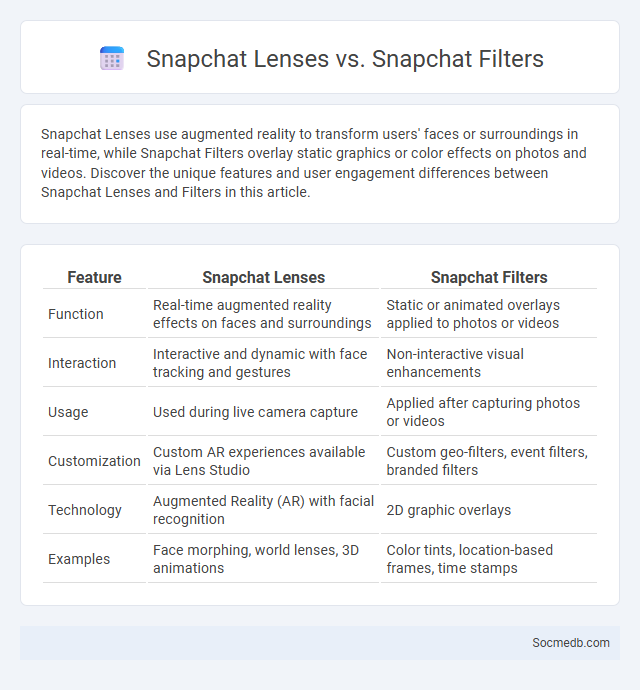
Photo illustration: Snapchat Lenses vs Snapchat Filters
Snapchat Lenses use augmented reality to transform users' faces or surroundings in real-time, while Snapchat Filters overlay static graphics or color effects on photos and videos. Discover the unique features and user engagement differences between Snapchat Lenses and Filters in this article.
Table of Comparison
| Feature | Snapchat Lenses | Snapchat Filters |
|---|---|---|
| Function | Real-time augmented reality effects on faces and surroundings | Static or animated overlays applied to photos or videos |
| Interaction | Interactive and dynamic with face tracking and gestures | Non-interactive visual enhancements |
| Usage | Used during live camera capture | Applied after capturing photos or videos |
| Customization | Custom AR experiences available via Lens Studio | Custom geo-filters, event filters, branded filters |
| Technology | Augmented Reality (AR) with facial recognition | 2D graphic overlays |
| Examples | Face morphing, world lenses, 3D animations | Color tints, location-based frames, time stamps |
Introduction to Snapchat Lenses and Filters
Snapchat Lenses and Filters transform your photos and videos by adding dynamic effects, animations, and augmented reality features that engage your audience uniquely. These tools allow you to express creativity, enhance your storytelling, and boost interaction on your social media profile. Using Snapchat Lenses and Filters strategically can increase your visibility and connect you with a broader community.
What Are Snapchat Lenses?
Snapchat Lenses are augmented reality filters that overlay dynamic animations and effects onto users' faces or surroundings in real-time. These lenses leverage facial recognition technology to create interactive and visually engaging experiences, from fun masks to transformative 3D graphics. Brands and creators often use Snapchat Lenses to boost user engagement and enhance social media marketing campaigns.
What Are Snapchat Filters?
Snapchat filters are augmented reality effects that enhance your photos and videos by adding visual elements like animations, colors, and face modifications in real time. These filters use facial recognition technology to accurately overlay effects, creating engaging and personalized content for your social media posts. Using Snapchat filters, you can transform ordinary snaps into creative expressions that boost your online interaction and storytelling.
Key Differences: Lenses vs. Filters
Lenses on social media alter your entire visual environment using augmented reality, transforming backgrounds and adding interactive elements for immersive experiences, while filters primarily adjust the appearance of your existing photo or video by enhancing colors, smoothing skin, or adding stylistic effects. Filters work by applying overlays and color grading directly to your image, whereas lenses use facial recognition and 3D mapping to create dynamic, real-time modifications. Your choice between lenses and filters depends on whether you want a simple aesthetic enhancement or a complete visual transformation that engages viewers interactively.
How Snapchat Lenses Work
Snapchat lenses use augmented reality (AR) technology and facial recognition algorithms to overlay interactive graphics and animations onto users' faces in real-time. These lenses utilize machine learning models that detect facial landmarks, enabling precise tracking of expressions and movements for dynamic visual effects. By combining AR with computer vision, Snapchat creates immersive experiences that engage millions of daily active users.
How Snapchat Filters Work
Snapchat filters use augmented reality (AR) technology combined with facial recognition algorithms to detect and map your facial features in real time. These filters apply graphical overlays or animations that interact dynamically with your expressions and movements, creating personalized and engaging visual effects. Your device's camera processes the data rapidly to ensure seamless integration, making the experience feel natural and immersive.
Popular Uses for Lenses on Snapchat
Popular uses for lenses on Snapchat include enhancing selfies with augmented reality effects, transforming your appearance with filters that add animations or change facial features, and creating interactive experiences that engage your audience. Many users leverage these lenses to express creativity, participate in viral challenges, or promote brands effectively. Your snaps gain more attention and appeal by incorporating these trendy and dynamic visual enhancements.
Creative Potential with Snapchat Filters
Snapchat filters unlock a vast realm of creative potential by allowing you to transform ordinary photos and videos into engaging, personalized content. These dynamic filters use augmented reality technology to enhance creativity, fostering unique storytelling and self-expression. Leveraging Snapchat's creative tools can significantly boost your social media presence and audience interaction.
Choosing Between Lenses and Filters
Choosing between lenses and filters on social media platforms hinges on the desired impact and authenticity of visual content. Lenses enhance real-time interaction with augmented reality effects, fostering engagement through dynamic expression, while filters refine images post-capture for consistency and aesthetic appeal. Strategic use of lenses aligns with trend-driven content, whereas filters support brand cohesion and polished storytelling.
Future Trends in Snapchat Visual Effects
Snapchat's future visual effects are set to leverage augmented reality (AR) to create immersive, interactive experiences that blend digital content with the real world, enhancing user engagement. Advanced AI-driven filters will enable hyper-personalized and context-aware effects, allowing Your snaps to reflect current moods, surroundings, or events seamlessly. Expect improvements in 3D object tracking and gesture recognition, making visual communications on Snapchat more dynamic and intuitive.
 socmedb.com
socmedb.com